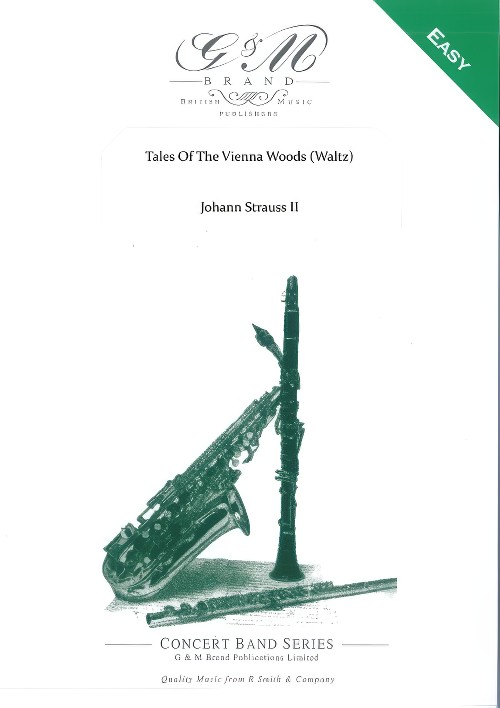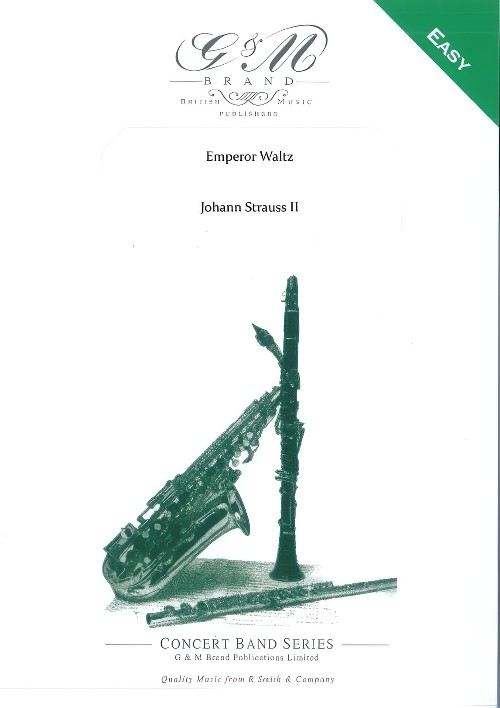Results
-
 £87.99
£87.99A Few Dots of Polka - Hans Christian Lumbye
Although known as the 'Waltz King' Johann Strauss II also wrote a large number of polkas. This clever mosaic by Ed Keeley, includes interwoven themes from The Czech Polka, Pizzicato Polka, Tritsch Tratsch Polka, Thunder & Lightning by Johann Strauss II, Lumbye's Champagne Galop and to finish, in fine classical foot-stomping style, the finale contains references to William Tell, Ode to Joy and 1812.
Estimated dispatch 7-14 working days
-
 £49.95
£49.95Tales Of The Vienna Woods (Waltz) (Concert Band - Score and Parts) - Brand, Geoffrey
Most of Johann Strauss' 'Master' Waltzes were written during the 1860's, including the "Blue Danube", "Morning Papers" and "Wine, Woman and Song", and this one is no exception. Like his father, Strauss toured virtually the whole of Europe with his orchestra, being acclaimed as Austria's King of the Waltz, and visiting the USA in 1876 to celebrate the centenary of Independence. This arrangement by Brand, Geoffrey simplifies the original version slightly but retains all the colour and flair of a sparkling bygone era.
Estimated dispatch 7-14 working days
-
 £9.95
£9.95Tales Of The Vienna Woods (Waltz) (Concert Band - Score Only) - Brand, Geoffrey
Most of Johann Strauss' 'Master' Waltzes were written during the 1860's, including the "Blue Danube", "Morning Papers" and "Wine, Woman and Song", and this one is no exception. Like his father, Strauss toured virtually the whole of Europe with his orchestra, being acclaimed as Austria's King of the Waltz, and visiting the USA in 1876 to celebrate the centenary of Independence. This arrangement by Brand, Geoffrey simplifies the original version slightly but retains all the colour and flair of a sparkling bygone era.
Estimated dispatch 7-14 working days
-
 £49.95
£49.95Emperor Waltz (Concert Band - Score and Parts) - Johnson, Stuart
Johann Strauss (the younger) was only six when he wrote his first waltz and it was obvious at an early stage that he would rival and outshine his father. His waltzes were meant for dancing - the opening bar is for partners to bow by way of introduction to each other - and when the "Emporor Waltz" was written in 1888, Strauss was director of the Imperial Court Balls in Vienna.
Estimated dispatch 7-14 working days
-
 £9.95
£9.95Emperor Waltz (Concert Band - Score Only) - Johnson, Stuart
Johann Strauss (the younger) was only six when he wrote his first waltz and it was obvious at an early stage that he would rival and outshine his father. His waltzes were meant for dancing - the opening bar is for partners to bow by way of introduction to each other - and when the "Emporor Waltz" was written in 1888, Strauss was director of the Imperial Court Balls in Vienna.
Estimated dispatch 7-14 working days
-
 £118.99
£118.99Kaiser-Walzer Wind Band Set (Score & Parts)
Everybody loves a Strauss waltz and they can beguaranteed to put a smile on the face of the audienceduring a concert. This waltz was composed in1888 by Johann Strauss, Jr. and many peopleconsider it to be his best composition - evenrivalling The Blue Danube.The Kaiser-Walzer has a quiet, rather melancholicopening, entirely in character with the personalityof the calm and dignified monarch Franz-Josef towhom it was dedicated. It is full of playful motifsand refined surprises and the lilting melody is sureto make everyone want to get up and dance. 0:13:20
Estimated dispatch 7-14 working days
-
 £137.99
£137.99The Gipsy Baron Wind Band Set (Score & Parts)
The operetta The Gipsy Baron is, together with Die Fledermaus (The Bat), the most famous theatre work by Johann Strauss Jr. A libretto full of romance, original musical ideas, compelling Viennese dances, fiery rhythmic Hungarian music and beautiful arias, were just some of the ingredients that lead to its huge success. The Gipsy Baron can also be thought of as a comic opera. The main motif of this overture won first prize in a contest that was to provide a new Hungarian anthem, however because Strauss did not have Hungarian nationality, another melody was chosen. A great transcription to bring a Hungarian twist to any programme. 0:08:15
Estimated dispatch 7-14 working days
-
 £113.30
£113.30Moderate Dances - Angelo Sormani
This piece is a tribute to dance music, especially passionate, intense and meditative dance music. "Moderate Dances" is divided into three movements: a "Tango", a "Slow Waltz" and a "Bossa Nova". Each movement and each dance has its own particular characteristics but, when combined, these different rhythmic beats and times give the piece a feeling of completeness and uniformity. The Tango started to flourish in the suburbs of Buenos Aires in around 1880. There is still some doubt as to its origins, which may be Cuban (Habanera) but are probably African. It was most popular in Argentina and Brazil: here the male protagonist was originally the "gaucho" with his inseparable guitar, later to be replaced by the proud, elegant "compadre". By around 1910 the Tango had spread to Italy and France. New clubs opened, where the upper classes could watch and dance the Tango. Here the dance also underwent some rapid transformations. The exaggerated and extravagant gestures and body movements disappeared. Slow, gliding steps replaced the old rotational movements. The women's red ankle-boots and the partners "staring into each other's eyes" accentuated the erotic nature and sensuality of this dance. So much so that, in 1913, the German government banned soldiers from dancing the Tango. Those who broke the law were immediately discharged from the army. From a strictly musical perspective, the basic instruments were a flute, a harp (the diatonic harp typically played by the Indians of Paraguay) and a violin, or flute, guitar and violin or even clarinet, guitar and violin. These instruments were easy to transport, ideal for playing at parties, in the streets and in courtyards. The musicians played by ear, frequently improvising: there were no scores, no records, which is the main reason why it is impossible to trace the Tango back to its exact origins. However, the Tango's evolution (and growing popularity) was once again fostered by its fundamental ability to absorb "other" cultures, languages and sounds. And it was the arrival of the "bandoneon" (an accordion-like instrument that was invented in Germany and brought to Rio de la Plata by some immigrant), which replaced the flute, that marked the beginning of the Tango's huge success outside Argentina. A number of talented composers, above all the great Astor Piazzola (1921-1992), transformed the bandoneon from a simple accompanying instrument to a solo instrument that was to become the distinguishing feature of the 20th century Tango. The Slow Waltz originated from the Waltz, the typical dance of the Bavarian and Tyrolese peasants in the 1700s. It was composers like Johann Strauss, father and son, who carried the Waltz to its zenith in the 1800s, creating the sensual and melancholy yet joyful and charming dance we are all familiar with. When the Waltz first became popular in Germany, the members of respectable society were shocked at the closeness of the dancing partners, who had always previously danced apart. The main difference between the Waltz and Slow Waltz is that the latter has a slower, more expressive rhythm: the men wear tails and the women wear ball gowns decorated with beads and feathers and couples dance in graceful rotational movements. "Bossa Nova" is the title of the last movement in the piece. Jobim, the great Brazilian musician, described this musical genre as a combination of modern Jazz and Samba. Bossa Nova means "new wave". This was the name of the artistic and musical movement that evolved in Brazil in the late Fifties and was extremely popular throughout the Sixties. The songs are usually about love or social matters, drawing inspiration from the slums of Rio De Janeiro and the lives of their inhabitants. Bossa Nova, with its original compositions and the artistic talent of its musicians, also became hugely popular in the United States and Europe, and top Jazz musicians (Ella Fitzgerald, Stan Getz, Bob Cooper, Charlie Bird, Sonny Rollins, Dexter Gordon, Dizzy Gillespie) started to include Bossa in their repertoires.
Estimated dispatch 7-14 working days
-
£89.99
Walzerzauber
The genre operetta (literally meaning 'small opera') originated halfway through the 19th century, as an antidote to the ever-lengthening opra comique, which by that time contained more and more tragic intrigues as well. In this charming work, three waltz melodies from different operettas come together. First, we hear 'Lippen schweigen' from Die lustige Witwe (The Merry Widow) by Franz Lhar (1870-1948). Then follows 'Ja, das alles auf Ehr' from Der Zigeunerbaron (The Gypsy Baron) by Johann Strauss the younger (1825-1899), after which 'Tanzen mchte ich' from Die Czardasfrstin by Emmerich Klmn (1882-1953) closes the medley in a cheerful way. Franz Watz has skilfullyconnected the waltzes to become a magical whole.
Estimated dispatch 7-14 working days
-
£134.99
Recalls - Ben Haemhouts
Recalls obviously refers to memories. This piece of music is in fact a series of flashbacks, however, it does not highlight the actual memories of specific thoughts, people or events.The composition evolves around the late Frans Steurs, who for manyyears was the inspirational artist behind the brass band that is currently commissioning this work. The main theme of the work is based on the name STEURS". E = mi, U = do, R = re and S = "si" which is Dutch for the note "ti". This idea forms themusical theme for the entire composition and different variations are used throughout. The structure of the work is based on the concept of a story which father Steurs is telling his two daughters, who play the flute and the clarinet. Each part ofthe work has a story-like character:1. Introduction: following a short ominous intro, the main theme is presented for the first time.2. The Story: father Steurs has both his daughters on his knee and he tells them stories from the old days. Trumpetsand trombones play variations of the theme. The story gets very exciting (accelerande, poco a poco agitato) until the tale takes a dramatic turn when the father tells an exciting story at the time of the Second World War. He tells of being hunteddown by the occupying army and these adventurous episodes are related to us musically in part3. Danger, with its skilful references to "vor dem Sturm" from "Eine Alpensinfonie" by Richard Strauss.4. called Fugitives, is about how he fled in the nightfrom the enemy and this is reflected in the bass tones of a new theme. The aggression of the war is illustrated from bar 117 onwards, by a harsh brass section. The main theme is repeated once again and this time up-tempo. The second theme is broughtonce again from bar 149 onwards.5. Dialogues, depicts the conversations between the two daughters and their father. Father speaks (bar 155); the daughters answer (bar 164 - flute, bar 166 - clarinet); bar 178: father answers with the tune of the maintheme to the two daughters. The discussions gradually intensify but ultimately end in peace in the last part called Conclusion.The piece of music "Recalls" is a free interpretation by the composer who consulted the letters between the two daughtersof Steurs and their father and in this respect it is not really music for a programme."
Estimated dispatch 7-14 working days
